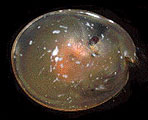
A few ocean creatures -- including some dinoflagellates
-- use chemical energy to produce light in a process called bioluminescence.
Although many bioluminescent animals live in the deep light-free ocean,
others live at or near the surface. One example is the small class of
crustaceans known as ostracods. Luminescent ostracods create two chemicals
which they release into the water. When these chemicals mix, one product
of the reaction is a blue-green light. Also, stirring up water in where
ostracods live can produce a green glow, often visible at night in the
wake of ships or in the crashing surf.
Raphael Dubois, who studied bioluminescence in clams
in 1887, coined the names luciferin and luciferase for two
components of bioluminescent systems. Luciferin is a species-specific
pigment. Luciferase is an enzyme that catalyzes the oxidation
of luciferin. Luciferin and luciferase occur in the salivary gland found
below the sea firefly's lower jaw. Luciferin and luciferase are released
into the sea water as granules. If the water is disturbed, the granules
dissolve and blue light is emitted. Luciferin acts directly as a substrate
in the generation of light. Luminescence occurs with the addition of oxygen
in the presence of luciferase and salts.
Energy comes from many different sources in the ocean.
Bioluminescence is a common biological energy source. In this activity,
students crush dried ostracods on a slide with a little water and observe
bioluminescence.
- Bioluminescence is formed from a chemical reaction within an organism
- This form of energy production is very common among sea organisms
- These energy bursts are utilized in a number of ways
Dried luminescent ostracods (can be mail ordered,
see below), Glass slide with slide cover, Water with eye dropper, "Glow
dough" or other glow-in-the-dark material, Glow stick (optional),
Fluorescent minerals and "black" light (optional)

- In a darkened room, place one or two dried ostracods on a slide.
- Place one drop of water on the ostracod.
- Cover and crush the ostracod with the slide cover.
- Write down what you observe. Can you see bioluminescence? What color is it?
- Animals and plants bioluminesce for a variety of reasons.
- Any ideas on why organisms might evolve the ability to glow?
- For example, luminescent ostracods in the ocean produce a bright cloud much larger than the ostracod itself... how might this be beneficial?
- Have students do library research project, each one on a different bioluminescent animal or plant.
Adapted from Orange County Marine
Institute and San Juan Institute activity series AND "Visit
to an Ocean Planet" CD-ROM, Copyright 1998, California Institute
of Technology and its licenses.








